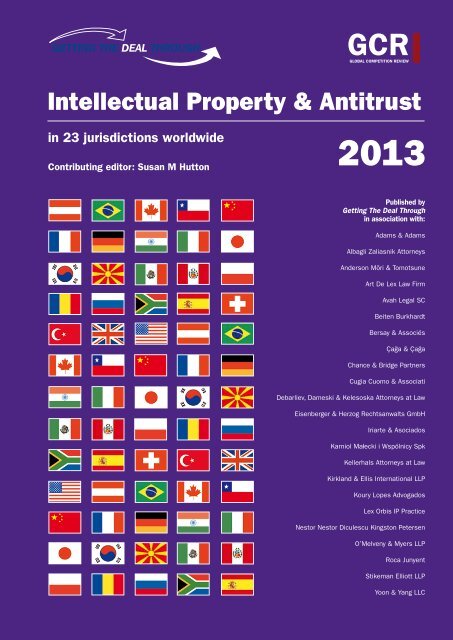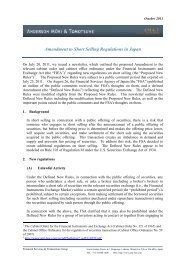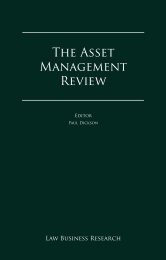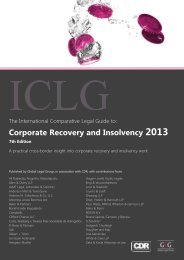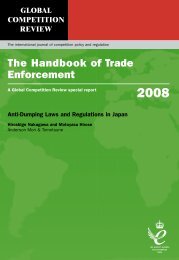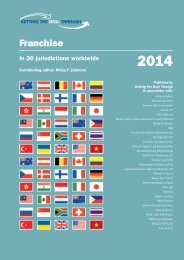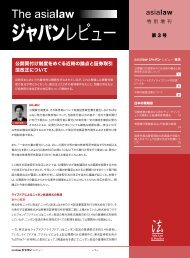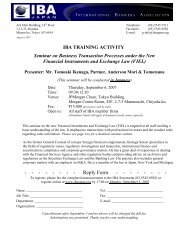"Intellectual Property & Antitrust" (Japan chapter)
"Intellectual Property & Antitrust" (Japan chapter)
"Intellectual Property & Antitrust" (Japan chapter)
You also want an ePaper? Increase the reach of your titles
YUMPU automatically turns print PDFs into web optimized ePapers that Google loves.
®GCRGLOBAL COMPETITION REVIEW<strong>Intellectual</strong> <strong>Property</strong> & Antitrustin 23 jurisdictions worldwideContributing editor: Susan M Hutton2013Published byGetting The Deal Throughin association with:Adams & AdamsAlbagli Zaliasnik AttorneysAnderson Mōri & TomotsuneArt De Lex Law FirmAvah Legal SCBeiten BurkhardtBersay & AssociésÇağa & ÇağaChance & Bridge PartnersCugia Cuomo & AssociatiDebarliev, Dameski & Kelesoska Attorneys at LawEisenberger & Herzog Rechtsanwalts GmbHIriarte & AsociadosKarniol Małecki i Wspólnicy SpkKellerhals Attorneys at LawKirkland & Ellis International LLPKoury Lopes AdvogadosLex Orbis IP PracticeNestor Nestor Diculescu Kingston PetersenO’Melveny & Myers LLPRoca JunyentStikeman Elliott LLPYoon & Yang LLC
contents®<strong>Intellectual</strong> <strong>Property</strong> &Antitrust 2013Contributing editor:Susan M HuttonStikeman Elliott LLPBusiness development managersAlan LeeGeorge IngledewRobyn HorsefieldDan WhiteMarketing managerRachel NurseMarketing assistantsMegan FriedmanZosia DemkowiczCady AtkinsonRobin SynnotAdministrative assistantsParween BainsSophie HickeyMarketing manager (subscriptions)Rachel Nursesubscriptions@gettingthedealthrough.comAssistant editorAdam MyersEditorial assistantLydia GergesSenior production editorJonathan CowieChief subeditorJonathan AllenSubeditorsMartin ForrestHarry PhillipsEditor-in-chiefCallum CampbellPublisherRichard Davey<strong>Intellectual</strong> <strong>Property</strong> & Antitrust 2013Published byLaw Business Research Ltd87 Lancaster RoadLondon, W11 1QQ, UKTel: +44 20 7908 1188Fax: +44 20 7229 6910Austria Dieter Thalhammer and Andreas Zellhofer Eisenberger & Herzog Rechtsanwalts GmbH 3Brazil Tiago Machado Cortez, Ana Carolina D’Atri and Eloy Rizzo Neto Koury Lopes Advogados 9Canada Susan M Hutton and Alexandra Stockwell Stikeman Elliott LLP 16Chile Ariela Agosin, Rodrigo Marin and Oscar Molina Albagli Zaliasnik Attorneys 26China Zhaofeng Zhou Chance & Bridge Partners 31France Emmanuel Schulte, Laurent Badiane and Marion Carrega Bersay & Associés 37Germany Matthias W Stecher, Philipp Cotta and Sebastian Heim Beiten Burkhardt 44India Abhai Pandey Lex Orbis IP Practice 51Italy Fabrizio Cugia di Sant’Orsola and Silvia Giampaolo Cugia Cuomo & Associati 56<strong>Japan</strong> Yusuke Nakano and Koya Uemura Anderson Mōri & Tomotsune 62Korea Wonil Kim and Kwang-Wook Lee Yoon & Yang LLC 68Macedonia Emilija Kelesoska Sholjakovska and Elena MicevaDebarliev, Dameski & Kelesoska Attorneys at Law 77Mexico Agustin Velázquez, Ronald Prat Celis, Victor Vila Velázquez andTomás Arankowsky-Tamés Avah Legal SC 82Peru Ruddy Medina Plasencia Iriarte & Asociados 88Poland Robert Małecki, Paweł Gutowski and Jan Karol WiegnerKarniol, Małecki i Wspólnicy Spk 93Romania Georgeta Harapcea and Delia Belciu Nestor Nestor Diculescu Kingston Petersen 99Russia Dmitry Magonya and Yaroslav Kulik Art De Lex Law Firm 106South Africa Alexis Apostolidis Adams & Adams 112Spain Pedro Callol, Anna Viladàs and Jorge Manzarbeitia Roca Junyent 118Switzerland Thomas Bähler and Daniel Emch Kellerhals Attorneys at Law 123Turkey Ömer Yiğit Aykan and Onur Ergönen Çağa & Çağa 129United Kingdom Pierre-André Dubois and Claire Callue Kirkland & Ellis International LLP 137United States Kenneth R O’Rourke and Stephen McIntyre O’Melveny & Myers LLP 144© Law Business Research Ltd 2012No photocopying: copyright licences donot apply.ISSN 1753-0628The information provided in this publication isgeneral and may not apply in a specific situation.Legal advice should always be sought beforetaking any legal action based on the informationprovided. This information is not intended tocreate, nor does receipt of it constitute, a lawyer–client relationship. No legal advice is being givenin the publication. The publishers and authorsaccept no responsibility for any acts or omissionscontained herein. Although the informationprovided is accurate as of November 2012, beadvised that this is a developing area.Printed and distributed byEncompass Print SolutionsTel: 0844 2480 112LawBusinessResearchwww.gettingthedealthrough.com
Anderson Mōri & Tomotsune<strong>Japan</strong>the protection and use of intellectual property, ensuring fair use andthe public interest shall be taken into consideration, and the promotionof fair and free competition shall also be considered. However,because this is just a general statement about the relationshipbetween IP rights and competition, specific interpretation of IP lawor competition law is unlikely to be affected by this provision.6 Remedies for deceptive practicesWith respect to trademarks, do competition or consumer protectionlaws provide remedies for deceptive practices in addition to traditional‘passing off’ or trademark infringement cases?Remedies against certain deceptive practices are provided for in theUnfair Competition Prevention Act (UCPA) with respect to trademarks.Where the UCPA is applicable, the person whose businessinterest is damaged may invoke its provisions regarding injunctionrights and compensation for damages, in addition to remedies undercivil law. Certain acts of this type also give rise to criminal liability.7 Technological protection measures and digital rights managementWith respect to copyright protection, is WIPO protection oftechnological protection measures and digital rights managementenforced in your jurisdiction? Does legislation or case law limit theability of manufacturers to incorporate TPM or DRM protection limitingthe platforms on which content can be played? Could TPM or DRMprotection be challenged under the competition laws?Yes. Both TPMs and DRMs are enforced in <strong>Japan</strong> under the CopyrightAct (CA). Regarding the protection of TPMs, a person whoassigns, leases or develops devices or programs that are solelydesigned to circumvent TPMs or who on a regular basis circumventsTPMs upon the request of the general public may be sentencedto a maximum of three years’ imprisonment or a fine of ¥3 million,or both (article 120-2, items 1 and 2 of the CA). A person whointends to privately copy those copyrighted works that are protectedby TPMs must obtain the consent of a copyright holder, which isan exception to the general rule that private copying is permittedwithout the copyright holder’s consent (article 30, paragraph 1, item2). Regarding the protection of DRMs, intentionally attaching falseinformation as DRMs, or removing or altering DRMs, is deemedinfringement of copyright (article 113, paragraph 3), and a personwho commits such an act with the intention of making a profit maybe sentenced to a maximum of three years’ imprisonment or a fineof ¥3 million, or both (article 120-2, item 3).No legislation or case law limits the ability of manufacturersto incorporate TPM or DRM protection limiting the platforms onwhich the content can be played. TPM or DRM protection is notgenerally considered anti-competitive, and we understand that mereemployment of TPM or DRM would not be challenged under competitionlaws.8 Industry standardsWhat consideration has been given in legislation or case law tothe impact of the adoption of proprietary technologies in industrystandards?Neither legislation nor case law has given special consideration tothe impact of proprietary technologies in industry standards. Thereis no compulsory licensing of technologies in industry standards;however, the Guidelines for the Use of <strong>Intellectual</strong> <strong>Property</strong> underthe Anti-Monopoly Act (IP Guidelines, 2007) published by the <strong>Japan</strong>Fair Trade Commission (JFTC) do provide such consideration, andstipulate that refusal of a licence can be deemed a violation of the Acton Prohibition of Private Monopolisation and Maintenance of FairTrade (No. 54 of 1947) (Anti-Monopoly Act, AMA) under certaincircumstances.One such example of a violation is where many companies arejointly developing a standard for certain products, and one of thecompanies has its technology adopted as a part of the standard byinappropriate measures (such as misrepresentation of possible termsand conditions of a licence of such technology after it is adopted asthe standard); after it successfully has the technology adopted, it thenrefuses to license the technology to other companies. Such refusal ofa licence may constitute private monopolisation or an unfair tradepractice.On the other hand, it seems logical to understand from the IPGuidelines that mere refusal to license technologies cannot be a violationof the AMA, even if such technologies have been adopted in certainstandards, unless the owner of such technologies has employedinappropriate measures in doing so.Competition9 Competition legislationWhat legislation sets out competition law?The AMA sets out the basic rules of competition law. Broadly, theAMA prohibits three types of activity:• private monopolisation (activities to exclude or control the businessactivities of other entrepreneurs);• unreasonable restraint of trade (activities to restrict or conductbusiness activities mutually with other entrepreneurs in such amanner as to fix, maintain or increase prices, limit productionor products, or other similar matters); and• unfair trade practices (boycott, unjust price discrimination, predatorypricing, resale price maintenance, abuse of a predominantbargaining position and other practices).It should be noted that while private monopolisation and unreasonablerestraint of trade require the level of restriction on competitionto be substantial, the tendency to impede competition would be consideredsufficient for the purpose of unfair trade practices. It can besaid that private monopolisation corresponds approximately to theabuse of dominant position under EU competition law, and unreasonablerestraint of trade includes almost all illegal cartels.Other important acts with aspects of competition law includethe Act against Unjustifiable Premiums and Misleading Representations(No. 134 of 1962), which prevents unjustifiable premiums andrepresentations regarding the trade of goods and services, and theUCPA, which provides for measures to prohibit unfair competitionand special rules regarding compensation for damages.10 IP rights in competition legislationDoes the competition legislation make specific mention of IP rights?Article 21 of the AMA provides that the AMA shall not apply to suchacts recognisable as the exercise of rights under the CA, Patent Act,Utility Model Act, Design Act or Trademark Act. However, holdersof IP rights should not rely on this provision without careful considerationof competition law, as this provision is quite general.11 Review and investigation of competitive effectWhich authorities may review or investigate the competitive effect ofconduct related to IP rights?The JFTC, an independent administrative committee responsiblefor competition-related matters, has general jurisdiction to reviewand investigate the competitive effects of certain conduct, includingthose related to IP rights. The courts may review the competitiveeffect of business practices, if civil or criminal lawsuits filedwith the court contain issues involving an effect on competition.The Tokyo High Court is the court of first instance for reviewingthe JFTC’s decisions upon an appeal filed by a respondent.www.gettingthedealthrough.com 63
<strong>Japan</strong>anderson Mōri & TomotsuneThe court may revoke the JFTC’s decision only if the facts on whichthe decision is based are not supported by substantial evidence, orthe decision violates the law.12 Competition-related remedies for private partiesDo private parties have competition-related remedies if they sufferharm from the exercise, licensing or transfer of IP rights?Yes, private parties have recourse to competition-related remedies.In addition to remedies available under civil law, the AMA providesfor two types of remedies for private parties. One is the right to seekan injunction.Broadly speaking, if a person suffers, or is likely to suffer, extremeharm from unfair trade practices by another, he or she can petitionthe court to issue an injunction order (AMA, article 24). The otherremedy is a claim for damages under AMA, article 25, whereby adefendant may not be discharged even if his or her act was not intentionalor negligent, which is contrary to general rules under civil law(AMA, article 25). However, this claim is not always useful becauseit may not be made unless the JFTC’s formal finding of violationbecomes final and conclusive.13 Competition guidelinesHas the competition authority issued guidelines or other statementsregarding the overlap of competition law and IP?The JFTC has issued three guidelines and one report regarding theoverlap of competition law and IP rights.The IP Guidelines discuss how to analyse legal issues arising frominteraction of competition law and IP rights.The Guidelines concerning Joint Research and Developmentunder the Anti-Monopoly Act (1993) provide that joint researchactivity itself is normally lawful if the total market share of participantsis not more than 20 per cent, but further provides that whetheror not covenants ancillary to joint research activities are lawful shallbe determined by taking various relevant facts into consideration, notlimited to the total market share.The Guidelines on Standardisation and Patent Pool Arrangements(2005) specify the circumstances where the formation of patentpools or licensing for standardisation through patent pools maygive rise to antitrust concerns.Views on Software Licensing Agreements, etc, under the Anti-Monopoly Act (2002) – which is an interim report, not guidelines– covers various issues arising from software licensing agreements,including abusive conduct by developers of operating systems softwareand restrictive covenants in software licensing agreements.14 Exemptions from competition lawAre there aspects or uses of IP rights that are specifically exempt fromthe application of competition law?Generally not, except that resale price maintenance of copyrightedworks between entrepreneurs is exempt from the AMA (article 23,paragraph 4). The JFTC’s interpretation is that ‘copyrighted works’include only the following six items: books, magazines, newspapers,music records, music tapes and music compact discs. DVDs, forexample, are not exempt.15 Copyright exhaustionDoes your jurisdiction have a doctrine of, or akin to, ‘copyrightexhaustion’ (EU) or ‘first sale’ (US)? If so, how does that doctrineinteract with competition laws, for example with regard to effortsto contract out of the doctrine, to control pricing of products solddownstream and to prevent ‘grey marketing’?Yes. The CA explicitly lays down a doctrine of exhaustion (article26-2, paragraph 2). The Act on the Circuit Layout of SemiconductorIntegrated Circuits (article 12, paragraph 3) and the Plant VarietyProtection and Seed Act (article 21, paragraph 4) have similar provisions.Notably, the CA specifically refers to ‘international exhaustion’,but the certain import of records lawfully sold outside of <strong>Japan</strong>for the purpose of resale in <strong>Japan</strong> is deemed copyright infringement(article 113, paragraph 5).In practice, the doctrine of exhaustion has been disputed mainlywith respect to patents and trademarks, particularly in the field ofparallel import (or ‘grey market’). Regardless of the lack of specificprovision on the exhaustion doctrine in the Patent Act and TrademarkAct, domestic exhaustion has been taken for granted. As tointernational exhaustion, the courts have recognised the doctrine andrejected claims of injunction by patent holders or trademark holders(or their licensees) against parallel importers that import genuineproducts (regarding patents, BBS Kraftfahrzeugtechnik v Racimex<strong>Japan</strong>, see question 32; regarding trademarks, NMC v Shriro Tradingin 1970).16 Import controlTo what extent can an IP rights holder prevent ‘grey-market’ orunauthorised importation or distribution of its products?As explained in question 15, an IP rights holder cannot prevent a ‘greymarket’ by exercising his or her IP rights against parallel importers.Moreover, the Guidelines concerning Distribution Systems and BusinessPractices under the Anti-Monopoly Act (Distribution Guidelines1991) stipulate that it may be a violation of the AMA for an authorisedgeneral agent of imported products or a foreign manufacturer(who may or may not be an IP rights holder) of the products, in orderto maintain the price of the authorised products:• to prevent foreign distributors from selling products to the greymarket;• to prevent domestic distributors from handling products importedthrough the grey market;• to prevent wholesalers from selling the products to retailers handlingproducts imported through the grey market;• to defame by stating that products imported through the greymarket are not genuine products;• to buy up the products imported through the grey market; and• to prevent newspapers or other media from carrying advertisementsof parallel importers.The Distribution Guidelines also stipulate that it would be a violationof the AMA for an authorised general agent, in order to maintainthe price of the authorised products, to refuse, or have distributorsrefuse, to repair products imported through the grey market or tosupply repair parts for products imported through the grey marketwhen it is extremely difficult for people or companies other thanan authorised general agent or a retailer to repair the products orprocure repair parts for the products.17 Competent authority jurisdictionAre there circumstances in which the competition authority may haveits jurisdiction ousted by, or will defer to, an IP-related authority, or viceversa?There are no circumstances where either the JFTC or the IP-relatedauthorities will defer to the other.Merger review18 Powers of competition authorityDoes the competition authority have the same powers with respectto reviewing mergers involving IP rights as it does with respect to anyother merger?Yes. The JFTC has the same powers with respect to reviewing mergersinvolving IP rights as in any other mergers.64 Getting the Deal Through – <strong>Intellectual</strong> <strong>Property</strong> & Antitrust 2013
Anderson Mōri & Tomotsune<strong>Japan</strong>19 Analysis of the competitive impact of a merger involving IP rightsDoes the competition authority’s analysis of the competitive impact ofa merger involving IP rights differ from a traditional analysis in which IPrights are not involved? If so, how?The standard for review by the JFTC of the competitive impact ofmergers is always the same (whether or not it ‘may be substantiallyto restrain competition’), irrespective of whether the mergers involveIP rights. Practically, such a test is whether the party after a mergercan increase the price at its own will, and the Herfindahl-HirschmanIndex before and after the merger plays an important role in termsof review by the JFTC (although in some cases the JFTC did notobject despite a very high post-merger figure). IP rights are one ofthe other relevant factors, and could play a significant role dependingon the case.20 Challenge of a mergerIn what circumstances might the competition authority challenge amerger involving the transfer or concentration of IP rights?For a general analysis, see question 19. We understand that theJFTC has never challenged a merger solely because the parties haveIP rights resulting in a strong competitive edge where the results ofcalculation of the Herfindahl-Hirschman Index do not raise significantconcern.21 Remedies to alleviate anti-competitive effectWhat remedies are available to alleviate the anti-competitive effect ofa merger involving IP rights?The JFTC may order any measures necessary to eliminate acts inviolation of the provisions regarding mergers (AMA, article 17-2,paragraph 1). Therefore, theoretically, mandatory licences may beordered as a remedy.In the course of merger review, sometimes antitrust concerns aredealt with by the parties who promise to take certain measures toalleviate such concerns. Some of these remedies are IP-specific. TheGuidelines to Application of the Anti-Monopoly Act ConcerningReview of Business Combination (the Merger Guidelines) issued bythe JFTC in 2004 provide that parties to business combinations maybe able to alleviate antitrust concerns if they grant the licence oftheir patent to competitors or new entrants on fair terms and conditions.In one case, the JFTC refrained from objecting to a merger onthe understanding that one of the parties would transfer or licensecertain rights regarding research and development, manufacturingand sales of overlapping products (In re Kirin Holdings and KyowaHakko Kogyo, 19 December 2008).Specific competition law violations22 ConspiracyDescribe how the exercise, licensing, or transfer of IP rights can relateto cartel or conspiracy conduct.The guidelines referred to in questions 8 and 13 introduce a numberof useful examples. As to patent pools, because they have a procompetitiveeffect, the ‘rule of reason’ test would be applied. Patentpools can constitute an unreasonable restraint of trade if membersof the patent pools share the understanding that they have acceptedcommon restrictions on trade conditions such as sales prices andsales areas, and such restrictions substantially restrict competition ina market, or if the members mutually restrict the area of research anddevelopment or prospective licensees of the IP rights.It should be noted that patent pools may also be regarded as privatemonopolisation or unfair trade practices. For example, if membersof patent pools refuse to grant a licence and effectively excludecompetitors, such a refusal may constitute private monopolisation.It will not be considered as cartel conduct for competitors tojointly license their IP rights to a certain licensee. On the other hand,if competitors jointly refuse to license their IP rights, it may be consideredas illegal cartel conduct.23 (Resale) price maintenanceDescribe how the exercise, licensing, or transfer of IP rights can relateto (resale) price maintenance.If a licensor sets minimum resale prices for its licensees, the licensor’sact is, in principle, considered to be an unfair trade practice (dealingon restrictive terms). Note that such vertical restraint is not generallyregulated as an unreasonable restraint of trade in <strong>Japan</strong> (seequestion 9).Acquisition and merger control – competition24 Exclusive dealing, tying and leveragingDescribe how the exercise, licensing, or transfer of IP rights can relateto exclusive dealing, tying and leveraging.An IP rights holder that restricts a licensee from manufacturing orusing competing products or adopting competing technologies maybe considered to have committed unfair trade practices (dealing onexclusive terms or dealing on restrictive terms), if such a restrictionresults in an adverse effect on competition in a market. In particular,if such a restriction is imposed after the expiration of the licensingagreement, it is highly likely that such a restriction will constituteunfair trade practices.An IP rights holder that obliges a licensee to obtain a packagelicence for more than one IP right may be considered to have committedunfair trade practices (tie-in sales), if such an obligation mayhave an adverse effect on competition in a market. For instance, in1998, the JFTC provided a recommendation decision to Microsoftthat it should not tie its MS Word and Outlook software with itsMS Excel software with regard to its licensing arrangements withPC manufacturers.25 Abuse of dominanceDescribe how the exercise, licensing, or transfer of IP rights can relateto abuse of dominance.Private monopolisation under the AMA is similar to abuse of dominantmarket position under EU competition law. If an entrepreneuror a combination of entrepreneurs in a dominant position excludesor controls the business activities of other entrepreneurs and therebycauses a substantial restraint of competition, such an abusive actwill constitute a private monopolisation. In the Paramount Bed case,a dominant manufacturer of beds for medical use approached anofficial of the Tokyo metropolitan government and made it adopt aspecification for beds that contained its IP rights by misrepresentingthat the specification somehow could also be reasonably satisfiedby its competitors, effectively excluding the business activities of itscompetitors. The JFTC held that Paramount Bed’s activities constitutedprivate monopolisation.In addition, it is becoming more likely than before that evenwhere the level of restriction on competition is not substantial,‘exploitation’ type conduct taking advantage of a predominant bargainingposition will be considered as ‘abuse of predominant bargainingposition’, which is one of the ‘unfair trade practices’ (seequestion 9). Although there has been no precedent in which theJFTC declared its policy to take such an approach with regard to IPrights, caution should be used in a potential patent hold-up case, forexample, particularly given that a surcharge (a type of administrativepenalty) shall be imposed on an ‘abuse of predominant bargainingposition’ if it occurs on a regular basis.www.gettingthedealthrough.com 65
<strong>Japan</strong>anderson Mōri & TomotsuneUpdate and trendsOn 12 June 2012, after a hearing procedure presided by hearingexaminers (whose role is similar to that of administrative law judges)for more than two years and more than one year of deliberation, theJFTC rendered a decree to cancel its own cease-and-desist orderdated 27 February 2009 against (alleged) private monopolisation bythe <strong>Japan</strong>ese Society for Rights of Authors, Composers and Publishers(JASRAC). The original charge was that JASRAC, the dominant musiccopyright collecting agency in <strong>Japan</strong>, excluded its rival, e-License,in a market of music copyright management for broadcasting byentering into ‘blanket licence agreements’ (agreements under whicha licensee is allowed to use an unlimited number of music worksmanaged by JASRAC by paying a licence fee of a fixed percentage ofthe licensee’s annual revenue in the business of broadcasting) withall broadcasting companies (including television stations and radiostations) in <strong>Japan</strong>. The cease-and-desist order was based on the logicthat the blanket licence agreements had the effect of excluding rivalsbecause the terrestrial television and radio stations were forced topay additional licence fees when they used music works managed byJASRAC’s competitors, while they could use an unlimited number ofmusic works managed by JASRAC without incurring such additionalfees. The JFTC’s original logic in the cease-and-desist order mighthave been theoretically right, but in the hearing procedure, JASRACsubmitted evidence showing that certain popular songs managedby e-License were actually aired by terrestrial television and radiostations frequently. Based on this, the hearing examiners found noexclusionary effect of the blanket licences, and cancelled the ceaseand-desistorder. This is the first case in the last 18 years where theJFTC has reversed its own decision based on its hearing procedure.26 Refusal to deal and essential facilitiesDescribe how the exercise, licensing, or transfer of IP rights can relateto refusal to deal and refusal to grant access to essential facilities.An entrepreneur’s mere refusal to license IP rights is generally thoughtto be beyond the scope of the AMA unless the entrepreneur has purchasedand collected IP rights or has employed inappropriate measures;no court judgment or JFTC decision has ever held a genuineunilateral refusal to license as being against the AMA. Moreover,no JFTC decision or court judgment has ever explicitly mentionedthe essential facilities doctrine. Theoretically, however, if an IP rightsholder singularly refuses to provide a licence to another entrepreneurand the entrepreneur faces difficulty in doing business because of theessential nature of the refused IP, the possibility that such a refusalto license could constitute private monopolisation or unfair tradepractices (other refusal to deal) cannot be ruled out.Remedies27 Remedies for violations of competition law involving IPWhat sanctions or remedies can the competition authority or courtsimpose for violations of competition law involving IP?In cases of violation of competition law involving IP, the JFTC mayissue a cease-and-desist order to take any measures necessary to eliminatesuch violation. However, whether ‘necessary measures’ couldinclude such drastic measures as compulsory licensing or divestitureof IP rights is unclear; to date, the JFTC has not ordered compulsorylicensing or divestiture of IP rights. If the violation is privatemonopolisation whereby a violator controls other enterprises’ businessactivities, subject to some additional requirements, the JFTCshould impose a surcharge (a type of an administrative penalty) onthe violators. In addition, if the violation is private monopolisationwhereby a violator excludes other enterprises’ business or certaintypes of unfair trade practices, the JFTC should impose a surchargeon the violators. Private parties who have been harmed by such actsof violation may seek an injunction or compensation for damages,or both.28 Competition law remedies specific to IPDo special remedies exist under your competition laws that arespecific to IP matters?Article 100 of the AMA lays down special sanctions that are specificto IP matters. That is, when the court pronounces a criminal sentenceon people who have committed private monopolisation or unreasonablerestraint of trade, it may order that the patents exercised forthe relevant offence be revoked. However, this sanction has neverpreviously been declared.29 Remedies and sanctionsWhat competition remedies or sanctions have been imposed in the IPcontext?The JFTC would typically order the violators to stop the violation,discard the relevant business policy, or both. For example, the JFTCordered members of a patent pool and the company that was managingthe pool to abandon their policy not to grant licences regardingthe pooled patents to non-members (In re Pachinko Patent Pool, 6August 1997).Yusuke NakanoKoya Uemurayusuke.nakano@amt-law.comkoya.uemura@amt-law.comIzumi Garden Tower Tel: +81 3 6888 10006-1 Roppongi 1-chome Fax: +81 3 6888 3065Minato-ku, Tokyo 106-6036www.amt-law.com<strong>Japan</strong>66 Getting the Deal Through – <strong>Intellectual</strong> <strong>Property</strong> & Antitrust 2013
Anderson Mōri & Tomotsune<strong>Japan</strong>30 Scrutiny of settlement agreementsHow will a settlement agreement terminating an IP infringementdispute be scrutinised from a competition perspective?Even a settlement agreement terminating IP infringement litigationwill be scrutinised in the same manner as any other agreement. Forexample, an agreement whereby a defendant agrees not to competewith respect to the patented product of a plaintiff may violate theAMA, especially if the plaintiff is ‘influential’ in the relevant market(namely, with a market share of not less than 10 per cent or a marketposition within the top three market players).Economics and application of competition law31 EconomicsWhat role has economics played in the application of competition lawto cases involving IP rights?Economics has so far played a quite limited role in the applicationof competition law to specific cases by the JFTC. IP-related cases areno exception to this.32 Recent casesHave there been any recent high-profile cases dealing with theintersection of competition law and IP rights?On 1 July 1997, the Supreme Court held that parallel imports ofgenuine products did not infringe a patentee’s right, unless the patenteehad agreed with purchasers outside of <strong>Japan</strong> to exclude <strong>Japan</strong>from a territory for sale or use of the products and put a distinctivenotice on the products of such agreements (BBS Kraftfahrzeugtechnikv Racimex <strong>Japan</strong>).On 16 September 2008, the JFTC held that Microsoft hadengaged in unfair trade practices (dealing on restrictive terms) byentering into agreements with PC manufacturers to license WindowsOS. Such agreements included a ‘non-assertion of patents’ (NAP)clause, which required licensees to not assert patent infringementclaims against Microsoft and other PC manufacturers. Microsoft didnot challenge the decision and it became final and binding.www.gettingthedealthrough.com 67
®Annual volumes published on:Air TransportAnti-Corruption RegulationAnti-Money LaunderingArbitrationAsset RecoveryBanking RegulationCartel RegulationClimate RegulationConstructionCopyrightCorporate GovernanceCorporate ImmigrationData Protection & PrivacyDispute ResolutionDominancee-CommerceElectricity RegulationEnforcement of ForeignJudgmentsEnvironmentForeign Investment ReviewFranchiseGas RegulationInsurance & Reinsurance<strong>Intellectual</strong> <strong>Property</strong> &AntitrustLabour & EmploymentLicensingLife SciencesMediationMerger ControlMergers & AcquisitionsMiningOil RegulationPatentsPharmaceutical AntitrustPrivate Antitrust LitigationPrivate ClientPrivate EquityProduct LiabilityProduct RecallProject FinancePublic ProcurementReal EstateRestructuring & InsolvencyRight of PublicitySecurities FinanceShipbuildingShippingTax on Inbound InvestmentTelecoms and MediaTrade & CustomsTrademarksVertical AgreementsFor more information or topurchase books, please visit:www.gettingthedealthrough.comThe Official Research Partner ofthe International Bar AssociationStrategic research partners ofthe ABA International section<strong>Intellectual</strong> <strong>Property</strong> & Antitrust 2013 ISSN 1753-0628


